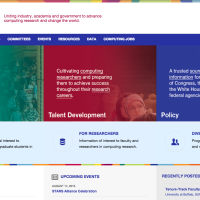New Leadership at the Computing Research Association

As I step up as Chair of the CRA Board of Directors, I’d like to share my thoughts about the organization, what it is doing, and what our next steps will be.
Prior to joining the Board, my understanding of what CRA did for the computing research community was limited to what affected me most as department chair: its biennial conference at Snowbird for computing leadership, the Taulbee Survey, several influential best practices papers related to promotion and tenure, and an outlet for faculty ads. Over the years, I have learned that this is just the tip of the proverbial iceberg, and my admiration for what the organization does has only grown.
For example, advocacy for computing research has now become the envy of many other fields through the work of CRA’s Government Affairs Committee. Consider:
- Congressional Visit Days, when colleagues from our community meet with members of Congress and their staff to advocate for computing research
- Leadership in Science Policy Institute (LISPI), which educates computing researchers on how science policy in the U.S. is formulated and how our government works
- Policy Blog, which keeps us up-to-date with what’s happening in Washington, D.C.
Other projects react to needs in the field. For example, responding to employment issues resulting from the economic downturn in 2008, the Computing Innovation Fellows (CIFellows) Project created NSF-funded postdoc opportunities for graduating PhDs. More recently, in response to concern about the increasing emphasis on quantity over quality in the current publication culture, a Committee on Best Practices for Hiring, Promotion, and Scholarship conducted interviews with more than 75 academic and industry computing and information unit heads to gain insights from practice, and advocated adjustments to hiring, promotion, and tenure practices, as well as to the publication culture through a Best Practice Memo.
Many of these activities occur via or in conjunction with CRA’s standing subcommittees, for example:
- Computing Community Consortium (CCC), whose visioning exercises have brought together scientists to formulate new research questions and problems of impact to society. CCC also led the CIFellows project, and enables funding for LISPI
- Committee on the Status of Women in Computing Research (CRA-W), whose advocacy and promotion of women have resulted in effective programs such as the Grad Cohort Workshop and Career Mentoring Workshops
- CRA Education Committee (CRA-E), whose emphasis on education has resulted in sessions on engaging undergraduates in research at various conferences, and provided resources for faculty and students on the Conquer website
- Center for Evaluating the Research Pipeline (CERP), whose emphasis on comparative evaluation has resulted in various studies that analyze the impact of diversity programs. Reports have been produced on career mentoring workshops, research experiences for undergraduates, and the CIFellows project
So, what’s next? There are several topics we are considering that the community has expressed interest in:
- Booming enrollments: How are growing enrollments affecting institutions, and what are they doing about it? How are they affecting students, and in particular diversity numbers?
- Data science: Many institutions are wrestling with the role that computer science should play in this new interdisciplinary field—whether to lead, what curricula to create, how to incorporate data science into existing programs. What are institutions across the country doing? What will the landscape look like in 15 years, and how should we prepare for it?
- Connections to industry: How can CRA better engage industry for the benefit of the research community?
As we move forward with these issues, we’d love to get your feedback—and hear about other issues you believe that CRA should address. Feel free to contact me, Vice Chair Susanne Hambrusch, or any of the other CRA Board members, to share your thoughts, volunteer to serve on one of the subcommittees, or express interest in running for the Board of Directors.
I’d like to thank our member organizations for their continued support, and you as a reader for your interest. Be sure to share the link to CRA’s new and improved website—CRA.org—to let others in your organization know about what CRA is doing!










